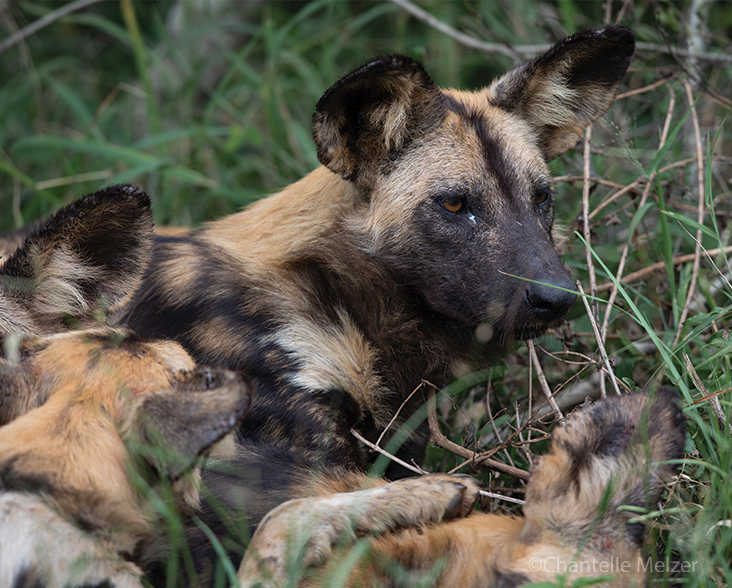African Wild Dog
Species Data
Class: Mammalia
Order: Carnivora
Family: Canidae
Scientific Name: Lycaon pictus
IUCN Red List status: Endangered
Description
Africa’s largest canid, the African Wild Dog, also known as the Hunting or Painted Dog, is easily recognised by its unmistakable short coat, blotched with black, white, brown, and yellowish-brown, giving a ‘painted’ appearance. Each individual has a unique colour pattern. There is no underfur, and sometimes the blackish skin shows through the coat where the fur is thin. The muzzle is black with a black line running between the eyes over the top of the head between the large, rounded ears. The forehead on either side of the black line is pale fawn to white. The body is slim with long legs, and each paw has four toes. Both sexes are roughly the same size, with a total body length between 105-150 cm, including a 30-40 cm long bushy white-tipped, or sometimes white with a black-tipped tail, and a shoulder height of 65-80 cm. Individuals range in weight from 20-30 kg.
Both male and female reach sexual maturity between 12-18 months old and their average lifespan in the wild is 10 years.
Behaviour
African Wild Dogs are social animals, living in packs typically numbering 10-15 individuals, although sometimes in groups of up to 40. Each pack has a dominant pair, the alpha male and alpha female, and each sex has its own dominance hierarchy. The pack usually has more males than females. This species is not territorial and, unusually amongst canids, only occasionally urine mark, but they do need large home ranges of up to 2,000 km2 (772 m2).
These mainly diurnal carnivores are most active in the cooler mornings and early evenings. They are cooperative hunters, hunting in packs led by the alpha male, using sight to find and target prey that is then chased at speeds of up to 55 kph (34 mph), sometimes over several kilometres, until the prey tires.
African Wild Dogs hunt prey averaging around 50 kg, mostly medium-sized antelope such as Impala and Greater Kudu, and also Common Wildebeest, Warthog, and Steenbok. They will also tackle larger animals up to 200 kg and smaller prey such as rats, hares, lizards, and birds. This species is a highly effective hunter, with an incredible 80% of hunts ending with a successful kill.
The breeding season runs from January to May. The alpha male mates with the alpha female and subordinate females are prevented from breeding, sometimes leading to aggressive behaviour. Pups are born between March and July after a gestation period of 60-80 days, and litters range in size from 2-20 pups, although eight pups are the average. The pups remain with their mother in the den, usually a grass-lined burrow, for three to four weeks, after which other females in the pack will also suckle the litter. Pups are weaned between 35-90 days, and at around 2 ½ years old, females will leave the pack to join other packs with no adult females. As well as caring for pups, the whole pack also cooperates in caring for injured and sick members.


Habitat
African Wild Dogs are found in a wide range of arid habitats from sea-level up to 4,000 m, including plains, deserts, savanna, and upland forest, but are absent from lowland forest.
Southern Africa is this species stronghold, especially northern Botswana, western Zimbabwe, eastern Namibia, western Zambia, Tanzania and northern Mozambique
Threats and Conservation
The main threat to the African Wild Dog is habitat loss and fragmentation, bringing this species into more contact with humans and domestic animals, leading to increasing human-wildlife conflict and transmission of infectious diseases.
The remaining populations are small and fragmented, reducing their genetic diversity and making them vulnerable to diseases and the effects of climate change. This species is frequently blamed for killing livestock and is shot, poisoned, and snared by farmers in retaliation.
Formerly widely distributed across sub-Saharan Africa, the African Wild Dog has almost entirely disappeared from the north and west of the continent and has massively declined in central Africa and the north-east. This species now occurs in just 14 of the 39 countries where they were formerly found and is categorised as Endangered on the IUCN Red List.
